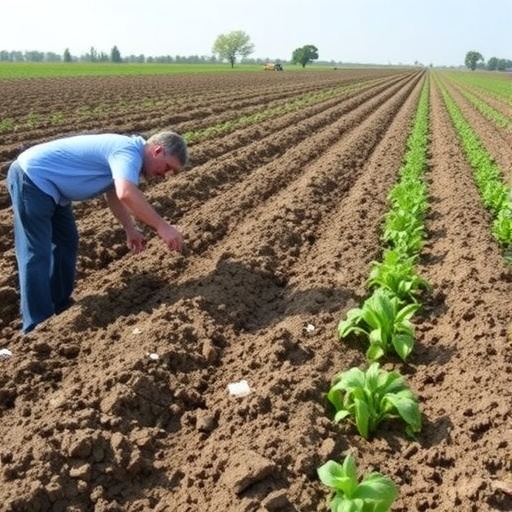
In the quest for sustainable agriculture, conservation tillage has emerged as a widely embraced practice, touted for its ability to enhance soil health and mitigate erosion. Yet, new research has uncovered a paradox within this well-intentioned approach: while the practice offers significant benefits at the soil level, it may inadvertently amplify environmental challenges downstream, including the intensification of hypoxic zones in aquatic ecosystems. This groundbreaking study by Liang, Zhang, McCarty, and colleagues delves into the complex interplay between conservation tillage methods in agricultural basins and their unexpected consequences extending all the way to gulf waters, providing crucial insights that deepen our understanding of agroecosystem impacts on global biogeochemical cycles.
Conservation tillage, characterized primarily by reduced soil disturbance and the maintenance of crop residues on the surface, has long been promoted as a cornerstone of soil conservation strategies. Its virtues are clear: bolstering soil organic matter, improving water retention, and encouraging biological activity within the soil matrix. These benefits contribute directly to increasing soil fertility and resilience, which are vital in sustaining crop productivity under changing climatic conditions. The researchers conducted exhaustive field measurements and laboratory analyses to quantify these advantages at the watershed scale, with results confirming consistent improvements in key soil health indicators such as aggregate stability, microbial biomass, and nutrient cycling efficiency.
However, the study also reveals a more complicated narrative when the effects of conservation tillage are traced downstream. Nutrient runoff, particularly nitrogen and phosphorus compounds, remains a critical concern surrounding modern agriculture due to its role in fueling eutrophication in aquatic systems. The authors employed an integrated basin-to-gulf assessment approach that combined hydrological models, nutrient flux measurements, and water quality data from riverine and gulf environments. Strikingly, despite reductions in soil erosion and sediment loads, conservation tillage practices did not mitigate nutrient export. Instead, they observed a disproportionate increase in dissolved reactive nitrogen concentrations entering waterways — a driver known to exacerbate hypoxic conditions in coastal zones.
The amplification of hypoxia, or oxygen depletion, in gulf waters poses severe ecological risks. Oxygen-starved zones resulting from eutrophication lead to mass mortality events for fish and benthic organisms, disrupt food webs, and diminish fisheries productivity. The researchers provide compelling evidence that agricultural fields managed with conservation tillage serve as persistent sources of nitrogen, especially nitrate, which readily leaches through the soil profile due to low disturbance and limited nitrogen immobilization in surface residues. This finding challenges assumptions that improved soil health unequivocally correlates with reduced nutrient pollution, underscoring the need to contextualize soil management within broader watershed nutrient dynamics.
Detailed isotopic tracing of nitrogen sources confirms that leached fertilizers and legacy nitrogen accumulating over years of intensive cropping contribute substantially to riverine nitrate loads. Conservation tillage may facilitate the mobilization of this nitrogen pool by enhancing soil porosity and water transport pathways, factors that accelerate the movement of soluble nutrients from fields to streams. Additionally, microbial processes influenced by reduced tillage may alter nitrogen transformation rates, potentially limiting denitrification — the natural microbial removal of reactive nitrogen as gaseous forms — hence allowing more nitrate to persist and migrate downstream. These mechanistic insights illustrate how soil-scale improvements can paradoxically propagate environmental harm at larger spatial scales.
The implications extend beyond localized pollution concerns, touching on the socioeconomic and policy spheres linked to agricultural sustainability and coastal resource management. As coastal hypoxia continues to threaten estuarine fisheries and recreational waters across the globe, this research calls into question one-size-fits-all recommendations for agricultural practices. Instead, it highlights the necessity of integrated nutrient management strategies that reconcile soil conservation goals with water quality protection. Approaches such as cover cropping, buffer strips, precision fertilization, and enhanced drainage control may be required alongside conservation tillage to address the complex nutrient fluxes revealed by the study.
Notably, the researchers emphasize that conservation tillage’s benefits remain significant and should not be dismissed. Improved soil health is indispensable for long-term agricultural viability and climate resilience. Yet, their results advocate for a nuanced understanding of agroecosystem trade-offs, where the cascading effects of land management decisions must be monitored at multiple scales—from soil microenvironments to coastal oceans—to effectively combat environmental degradation. The study embodies an important step toward systems-thinking in agricultural science, encouraging collaboration between soil scientists, hydrologists, ecologists, and policymakers.
Moreover, this research underscores the urgency of deploying innovative technologies and monitoring frameworks capable of capturing nutrient pathways in real time. Emerging tools such as remote sensing, sensor networks, and advanced modeling platforms could enhance predictive capacity and inform adaptive management interventions. By operationalizing basin-to-gulf perspectives, stakeholders can better anticipate unintended consequences and optimize agricultural landscapes that support food security without compromising aquatic ecosystem health.
In conclusion, the work of Liang and colleagues transforms the narrative around conservation tillage from a solely positive soil amendment practice to a complex environmental paradigm. Their integrative analysis reminds us that interventions in one component of the agricultural system ripple through interconnected ecological compartments, sometimes with counterproductive outcomes. This deeper understanding ignites a call for multidimensional stewardship that balances the interlinked goals of soil integrity, water quality, and biodiversity conservation. The future of sustainable agriculture hinges upon such holistic and evidence-driven frameworks, paving the way for solutions that nourish both the land and the waters it sustains.
Subject of Research: The environmental impacts of conservation tillage practices on soil health and downstream aquatic hypoxia.
Article Title: From basin to gulf: Conservation tillage improves soil health but exacerbates hypoxia.
Article References:
Liang, K., Zhang, X., McCarty, G.W. et al. From basin to gulf: Conservation tillage improves soil health but exacerbates hypoxia. npj Sustain. Agric. 3, 47 (2025). https://doi.org/10.1038/s44264-025-00090-0
Image Credits: AI Generated
Tags: agricultural sustainability challengesagroecosystem biogeochemical cyclesclimate change and agriculture resilienceconservation tillage benefitscrop residue management techniquesenvironmental impacts of agricultureGulf hypoxic zones researchhypoxia in aquatic ecosystemssoil conservation strategiessoil health improvement practicesunintended consequences of tillage methodswater retention in farming




